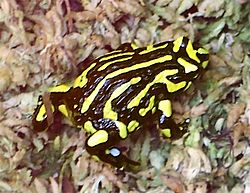Southern corroboree frog facts for kids
Quick facts for kids Southern corroboree frog |
|
|---|---|
 |
|
| Conservation status | |
| Scientific classification | |
| Kingdom: | |
| Phylum: | |
| Class: | |
| Order: | |
| Family: | |
| Genus: | |
| Binomial name | |
| Pseudophryne corroboree Moore, 1953
|
|
The southern corroboree frog (Pseudophryne corroboree) is a tiny, brightly colored frog. It's one of two types of corroboree frogs, the other being the northern corroboree frog. These frogs are famous for their amazing black and yellow stripes, which sometimes have a hint of green. They are among the most colorful frogs in the world!
These special frogs live in a very small area, only about 10 square kilometers (3.9 sq mi), within the Kosciusko National Park in southeastern Australia. Scientists believe there are fewer than 250 southern corroboree frogs left in the wild. Their numbers have dropped by 80% in just the last ten years. Because of this, the IUCN has listed them as a critically endangered species. This means they are at a very high risk of disappearing forever.
Contents
Where do corroboree frogs live?
Southern corroboree frogs make their home in a small part of Kosciusko National Park. They usually live in cold places like Snow Gum forests and Sphagnum swamps. These areas are high up, more than 1,000 meters (3,300 ft) above sea level. During the summer, they breed in small ponds and wet areas.
What do corroboree frogs look like?
The southern corroboree frog has a very unique pattern of black and bright yellow stripes. These frogs are quite small. When they are fully grown, they are only about 25 millimeters (1 in) long. Female frogs are usually a bit bigger than males, sometimes reaching 30 millimeters (1.2 in).
What do corroboree frogs eat?
These frogs mainly eat small bugs. Their diet includes ants, beetles, and mites.
Corroboree frog reproduction and life cycle
Corroboree frogs have a very different breeding cycle compared to most other frogs. Most frogs lay their eggs in spring, but these frogs only breed in summer. This happens during January and February. They dig small holes in wet areas for mating and laying their eggs. A female frog can lay between 16 and 40 eggs.
The eggs hatch 4 to 6 months later. This happens when water levels rise and flood the nests. The young frogs, called tadpoles, live in the water for another 6 to 8 months. They then change into frogs at the start of summer, usually in December. They become ready to have their own babies after another two years. Sadly, these frogs usually do not survive to breed a second time.
How do corroboree frogs protect themselves?
Corroboree frogs are special because they are the first vertebrates (animals with backbones) found that can make their own poison. This poison is a type of chemical called an alkaloid, specifically pseudo-phrynamine. Most other frogs get their poison from the food they eat. The frog's skin releases this alkaloid to protect itself from predators. It might also help fight off skin infections caused by tiny microbes.
Why are corroboree frogs endangered?
The southern corroboree frog is Australia’s most endangered frog. Scientists are still trying to figure out all the reasons why their numbers have dropped so much. However, there are several big problems affecting the areas where they live.
Threats to their habitat
One problem is that more people are visiting their habitat with four-wheel drive vehicles. Also, new ski resorts are being built. Both of these activities can destroy the frogs' homes.
Climate change and disease
Global warming is also a big threat. These frogs are used to very cold weather. Warmer temperatures might shorten their breeding time during winter. It could also melt the snow they rely on. Holes in the ozone layer are another concern. More sun rays hitting the ground mean less snow, which is bad for their habitat. Diseases caused by funguses can also kill many frogs.
Water pollution and wild animals
Erosion and pollution of the waterways where they breed can kill the frogs' eggs. Wild pigs also cause problems by destroying the wetlands where the frogs live.
What is being done to help corroboree frogs?
The NSW National Parks and Wildlife Service is working hard to save these frogs. They are breeding the frogs in laboratories. Once the frogs are fully grown, they are released back into the wild. After the big bushfires in the summers of 2002 and 2003, all the eggs found in the wild were collected. They were taken to the Melbourne Zoo to be hatched safely.
See also
 In Spanish: Pseudophryne corroboree para niños
In Spanish: Pseudophryne corroboree para niños
Images for kids



